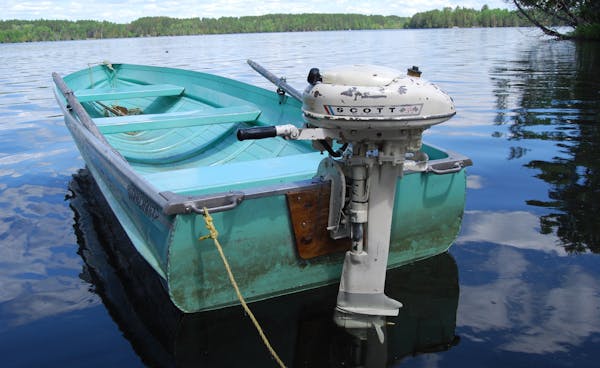Among rock climbers, the rock walls around Sandstone, Minn., are famous for offering some of the best bouldering in the state. Now the climbing area is expanding, a move that one climbing enthusiast said could eventually create "hundreds of problems."
But don't worry — that's a good thing.
In bouldering lingo, a "problem" is a specific route up the rocks. A challenge. A problem to be solved.
Until recently, the climbing community faced a couple of actual problems in the area, which surrounds the Kettle River. Although nearby Banning State Park offered much climbing potential, historically the park was not open to climbing. Then last year came bad news: Another popular climbing area, a 108-acre piece of private land between Sandstone and the park, was being put up for sale and could become unavailable, too.
But a remarkably cooperative effort involving four entities — the Minnesota Climbers Association, the city of Sandstone, the Parks and Trails Council of Minnesota and the Minnesota Department of Natural Resources (DNR) — solved both problems, securing the private land and even opening Banning to climbers.
Now many more climbing spots are likely on the way, said Jeff Engel, a Climbers Association board member, making the area into an even more powerful magnet for climbing enthusiasts.
"It's a really an inspiring story about how an organized group of people with a passion for protecting incredible natural resources can come together and take the kind of action that's going to benefit generations of Minnesotans, including some who aren't even born yet," said Brett Feldman, executive director of the Parks and Trails Council.
The Sandstone area is particularly good for bouldering, an increasingly popular style of rope-free climbing that uses crash pads spread on the ground in case of falls.
"Lot of kids starting climbing now think bouldering is way cooler than tying in on a rope," Engel said.
In winter, ice climbing in Sandstone draws enthusiasts from throughout the Upper Midwest. Some of the ice is "farmed," or created with water drawn from a hydrant provided by the city. Some glows from within, thanks to LED lights frozen inside.
"When you get those dark winter nights, it's spectacular," said Sandstone City Administrator Samuel Griffith.
A decade of climbing
Climbing has been popular in Sandstone's Robinson Park, a former quarry that was "the reason Sandstone exists," Griffith said, for at least 10 years. City officials overcame initial safety concerns, agreeing to allow and even encourage climbing after meeting with climbers themselves.
"It took us a long time to get us to a comfort level," Griffith said. "But look at these [climbers]. It's safety, safety, safety — and then they climb."
Because Banning did not permit climbing, climbers stayed clear, even though the park offered "an amazing amount of rock," said Sean Foster, also a Climbers Association board member.
"It's widely known that, while there's rock there, if you went in and started climbing you could damage relationships, so we didn't do it. The climbing community is very respectful and aware of how fragile it can be to maintain access. … There's an unspoken agreement that we follow rules."
Fortunately, climbers had been given the owner's permission to venture onto the nearby private property.
"That piece of land has some of the best sandstone boulders in the entire Midwest, let alone Minnesota," Foster said.
But in 2013, the property went up for sale.
"The thought of losing that 108 acres was devastating to the community," he said.
Finding solutions
The Climbers Association turned for help to the Parks and Trails Council, a nonprofit organization that acquires land for public use. The council agreed to purchase the $250,000 property — if the climbers would demonstrate their commitment by contributing 10 percent of the cost.
The climbers held fundraisers, sold raffle tickets and T-shirts. As fall approached, they were still short of their $25,000 goal, "so we decided to throw an event and we called it the Save Sandstone Festival," Foster said.
More than 100 people turned out for the event last October, with day climbing, night climbing, a bonfire, a feature film projected onto a rock face ("Cliffhanger," starring Sylvester Stone, is considered ridiculous among climbers for inauthenticity, but they had fun ridiculing it). In the end they exceeded their goal by at least $5,000, Foster said.
The Parks and Trails Council bought the land. The climbers used the additional money to improve access, parking and trails. Eventually, the DNR is expected to acquire the land and add it to Banning. So meanwhile, the DNR took another look at its rules and decided to permit climbing in Banning.
The DNR is in the process of examining and designating specific climbing sites. The organization needs to make sure the activity won't disturb the rare ferns and grasses that grow in the park. The DNR also wants to protect the northern long-eared bats — a species being considered for endangered status — that hibernate in a cave in Banning.
"We have to do due diligence to make sure the natural resources there are appropriately managed," said Dave Olfelt, the DNR's acting operations manager for parks and trails in northeast Minnesota. "Climbers are a really cool bunch of people … but anytime people go in the outdoors, there's some sort of impact."
Meanwhile, the Climbers Association held a repeat of last year's fundraising party last weekend, this time calling it the Saved Sandstone Festival (past tense), to celebrate the developments.
"Everybody just had a grand time," Engel said.
Katy Read • 612-673-4583
